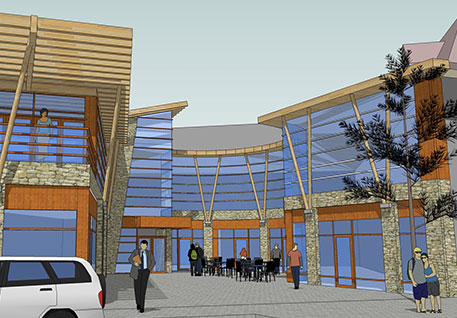Why commercial architects Use Regulatory Knowledge to Streamline the Planning Process
Wiki Article
Introducing the Comprehensive Services Offered by Commercial Architects for Modern Developments
Commercial Architects serve an important function in modern advancement jobs. They mix layout aesthetics with functionality while adhering to regulative demands. Their proficiency extends beyond simple building, integrating lasting practices and cutting-edge innovations. As they browse complicated zoning regulations, Architects collaborate with different stakeholders to bring visions to life. This complex method questions concerning the developing duty of Architects fit modern-day areas and the impact of their deal with future advancements.Comprehending the Role of Commercial Architects in Modern Developments
In contemporary metropolitan landscapes, Commercial Architects play an essential duty fit functional and aesthetic rooms that satisfy diverse business needs. Their proficiency expands beyond simple design; they navigate complicated zoning laws, constructing codes, and ecological laws. By teaming up with clients, they identify particular demands, making certain that each project straightens with the customer's vision while likewise taking into consideration practical aspects such as sustainability and cost-effectiveness. Commercial Architects are proficient at incorporating ingenious technologies and materials into their designs, enhancing both the capability and energy efficiency of structures. They perform comprehensive website evaluations to analyze the prospective obstacles and possibilities offered by an area. In addition, efficient interaction with specialists and other stakeholders is necessary, guaranteeing that the project proceeds smoothly from perception to completion. Ultimately, Commercial Architects are crucial in creating areas that not just satisfy useful functions yet likewise add to the general personality and vibrancy of urban settings.Idea Style: Transforming Concepts Into Truth
Principle design functions as an important phase in Commercial architecture, where innovative layout solutions arise from innovative thinking. This process counts on joint ideation, bringing together diverse viewpoints to improve and improve preliminary principles. As concepts take shape, they change from abstract concepts into tangible architectural facts.Cutting-edge Design Solutions
Changing concepts into reality is the trademark of innovative style remedies in Commercial style. These options mix creativity with functionality, dealing with the one-of-a-kind demands of contemporary advancements. By leveraging sophisticated modern technologies and lasting techniques, Architects craft areas that are not just aesthetically appealing however additionally effective and adaptable. Emphasis on user experience drives the layout procedure, guaranteeing that settings foster efficiency and cooperation. Each task gain from a tailored strategy, where principles are diligently created to show the client's vision while thinking about future fads. Innovative style remedies also focus on flexibility, enabling modifications gradually as organization requirements advance. Inevitably, these techniques improve the general value of Commercial spaces, making them pivotal in today's affordable landscape.
Joint Ideation Process
Collaboration serves as the backbone of the ideation procedure in Commercial architecture, fostering creativity and development among diverse stakeholders. Architects, clients, designers, and area participants take part in dynamic conversations, ensuring that all point of views are taken into consideration. This comprehensive method enables the exploration of various design principles, encouraging one-of-a-kind services that align with the project's vision. With workshops and conceptualizing sessions, concepts evolve and refine, transforming initial concepts into tangible designs. Modern technology likewise plays a crucial function, with devices such as Structure Information Modeling (BIM) facilitating real-time partnership and modifications. Inevitably, this collaborative ideation process not just enhances the style result but also grows a feeling of ownership and investment amongst all parties included, resulting in effective Commercial developments.Zoning Evaluation: Navigating Regulations and Conformity
As designers start on brand-new projects, understanding zoning policies is crucial to guaranteeing compliance and preventing costly hold-ups. Zoning evaluation plays an essential role in this process, as it entails assessing regional zoning regulations that dictate land use, developing elevation, thickness, and problems. Commercial Architects possess the know-how to navigate these complex laws, aiding customers recognize acceptable uses and any type of required variations.Lasting Design Practices: Building for the Future
Sustainable layout practices are significantly important in the domain of Commercial style, particularly as ecological concerns continue to rise. Architects prioritize environmentally friendly materials, energy-efficient systems, and design approaches that decrease waste and environmental effect. Integrating sustainable power resources, such as solar panels and wind generators, enables structures to produce their very own power and lower dependence on fossil fuels.Furthermore, sustainable design stresses the significance of interior ecological top quality. This includes making use of all-natural light, enhancing air flow, and internet choosing non-toxic materials to boost occupant health and wellness and performance. Environment-friendly roof coverings and living wall surfaces are likewise preferred attributes that add to biodiversity and urban cooling.Additionally, Commercial Architects frequently integrate water conservation methods, like rainwater harvesting and drought-resistant landscape design. With these cutting-edge methods, they develop spaces that not just fulfill modern requirements yet likewise promote a sustainable future, dealing web link with the expanding need for accountable advancement in the modern-day world.Job Administration: Ensuring Timely and Reliable Execution
Reliable task administration is crucial for guaranteeing that Commercial style projects are completed on time and within spending plan. This duty incorporates an array of responsibilities, consisting of the control of numerous stakeholders, timelines, and resources. Commercial Architects utilize their knowledge to create detailed task strategies that detail important turning points and deliverables, enabling methodical development tracking.Regular interaction amongst staff member and customers is vital, promoting transparency and helping with timely decision-making. Threat administration methods are additionally employed to identify prospective obstacles early, enabling positive services to be created. By using innovative task monitoring tools, Architects can keep an eye on job efficiency in real-time, making modifications as needed to preserve effectiveness.Interior Decoration: Creating Practical and Aesthetic Rooms
Inside style plays an important duty in boosting both capability and appearance within Commercial spaces. Effective space preparation can maximize operations and boost individual experience, while visual style principles contribute to a visually attractive setting - commercial architects. Together, these components create rooms that are not only sensible yet also motivatingSpace Preparation Efficiency
While taking full advantage of the energy of available area, Commercial Architects prioritize area planning efficiency to produce both practical and aesthetically pleasing environments. This strategy entails careful analysis of the spatial design to guarantee optimal use of every square foot. Architects take into consideration aspects such as operations, ease of access, and all-natural light to improve functionality. By strategically putting furnishings, equipment, and workstations, they promote motion and communication among users, promoting performance. Additionally, zoning various locations for particular functions assists in managing noise and privacy, creating an unified atmosphere. With efficient space planning, Commercial Architects can change constraints right into possibilities, making sure that each area satisfies the diverse demands of its passengers while sticking to regulative requirements and industry requirements.Aesthetic Style Concepts
Visual read layout principles play a vital duty fit environments that are not only functional however additionally aesthetically appealing. These principles lead Commercial Architects in producing spaces that reverberate with individuals while boosting brand name identity. Trick components consist of equilibrium, proportion, and consistency, which collaborate to develop a natural look. Color design and products are carefully chosen to evoke wanted emotions and sustain the total style. Furthermore, lighting plays an important role, affecting mood and visibility while highlighting building attributes. By incorporating these principles, Architects guarantee that areas are not only sensible however also welcoming and motivating. Ultimately, effective visual style promotes a favorable user experience, encouraging involvement and complete satisfaction in Commercial atmospheres.Partnership With Stakeholders: Fostering Successful Collaborations
Successful partnerships in Commercial style rest on reliable collaboration with stakeholders, ensuring that every voice is listened to and valued. This collective strategy includes interesting various celebrations, including customers, service providers, and area members, throughout the layout and growth process. By promoting open communication, Commercial Architects can attend to problems, collect insights, and straighten the job's vision with stakeholder expectations.The integration of diverse point of views enhances imagination and development, bring about even more functional and cosmetically pleasing designs. Regular conferences, feedback sessions, and workshops promote this discussion, enabling Architects to adapt their strategies in reaction to stakeholder input. Furthermore, developing trust with transparency and responsibility reinforces these partnerships, causing a smoother task execution.Ultimately, the success of contemporary advancements relies on the Architects' capacity to browse and integrate differing rate of interests, developing a collective atmosphere that promotes shared goals and mutual success.Frequently Asked Inquiries
Exactly How Do Commercial Architects Manage Budget Constraints Throughout a Job?

What Sorts of Software Do Commercial Architects Typically Utilize?
Commercial Architects commonly utilize software program such as AutoCAD for composing, Revit for Building Details Modeling, SketchUp for 3D modeling, and task management tools like Microsoft Job to enhance collaboration and simplify workflows throughout the style process.Can Commercial Architects Help With Acquiring Financing for Projects?
Commercial Architects can help in acquiring financing for tasks by preparing in-depth propositions, assisting to articulate style visions, and supplying financial projections that can enhance the probability of protecting required financing from financiers or monetary organizations.How Do Architects Guarantee Security Throughout the Construction Refine?
Architects guarantee safety during building by executing rigorous design criteria, coordinating with designers, carrying out routine website assessments, adhering to regional regulations, and cultivating communication amongst all stakeholders to mitigate dangers and advertise a protected functioning atmosphere.What Recurring Assistance Do Architects Provide After Task Conclusion?
After job conclusion, Architects supply ongoing assistance through upkeep consultations, efficiency analyses, and layout modifications. They ensure structures satisfy progressing needs, address prospective concerns, and maintain compliance with laws, promoting a long-term connection with clients.Report this wiki page